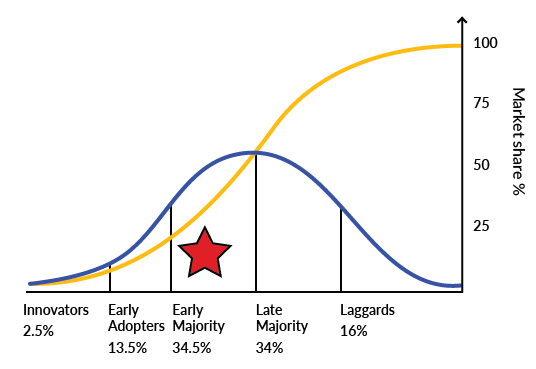Corporate Social Impact: The New Normal
This is the third of a four-part article series looking at Measuring Your ROi – The Return on Your Impact Investment™. This series is developed by ActionsProve, LLC.
Our first two articles have set the stage for understanding the potential of Corporate Social Impact (CSI) with a fresh look at the non-profit sector and the introduction of a formula for personal significance. CSI today is more than an expectation of our future employees and top client prospects – it is a Movement. It is a culmination of 30 years of societal transformation, and it has already taken hold. CSI has become a requirement for long-term business success – the new normal. CSI offers the opportunity for us to leverage the power of commerce, intentional investment and harmonized human capital to help those who are hurting, suffer from injustice, have untapped potential and want to grow – and do so in a way that has a lasting benefit for all stakeholders.
We Have Changed
Since the late 1980s we have seen the fall of communism, the development of the internet, the rise of disruptive and democrative technologies, unprecedented levels of connectedness and information transfer, increases in education and wealth, a rise in both environmental and social consciousness, and a strong desire for greater meaning and purpose and a more integrated life. For sustainable success today, businesses need to both aspire toward and deliver a higher purpose. Businesses must be positioned to work with, and not against, these transformative changes in order to attract, inspire and retain the best talent to serve its customers. Businesses with a sole focus on profits simply cannot compete with this social transformation.
Commerce and jobs matter. They provide fuel to our society. However, many of our best employees want more than a job – they want to matter both at work and at life. They want to be successful in order to provide for themselves and their families, and they want to grow. They want to also be connected to others and contribute to a greater good. The reality today for most people is that life is busy and success is consuming. There is often not much time or energy left in the day for connection and contribution. Business leaders must recognize this disconnect and act before discontent, burnout and regret can seed and take hold. Effective CSI can help align and integrate an employee’s desire for both success and greater significance and do so for the benefit of all stakeholders. Without this, businesses could run the risk of not attracting or retaining top junior-level staff, as well as losing top senior-level talent to a career change or pivot, particularly as they enter their mid- and later-life seasons and have more flexibility.
Business Has Changed
Many business owners and executives are high-capacity people who are heavily invested in the operations and growth of their businesses. This is beneficial in multiple ways to many different stakeholders. However, there is a problem. Our busyness and focus can blind us. Statistically, we lose ‘Emotional Intelligence’ as we climb the corporate ladder and operate at high-level positions within our businesses (Emotional Intelligence 2.0, Drs. Travis Bradberry and Jean Greaves). Our Emotional Intelligence is the measure of our self-awareness, self-management, social awareness and our relationship-management. These elements are all tied to effective CSI. Although many business leaders have not been able to see or understand the transformation that has occurred due to this loss in Emotional Intelligence, it is something we can rebuild as we choose to devote more time to becoming more self- and socially-aware, and act accordingly. The most successful businesses have leaders with high levels of Emotional Intelligence.

Most companies today are engaging in some form of CSI. CSI can at times be interchanged with Corporate Social Responsibility (CSR) or Corporate Responsibility (CR). There are distinctions but for the purposes of this article, we can assume all to be associated with businesses looking to ‘do good’ and make a difference while being responsive to the need to successfully operate and create high value and profits for the benefit of customers, employees and other stakeholders. There is a broad range of activities that can be identified as CSI, and activities are often within environmental, social or governance domains.
A study was recently conducted to identify different archetypes of Fortune 500 companies related to CSI (Deloitte, 2015). These archetypes ranged from “shareholder maximizers” representing 11% of the cohort, to “corporate contributors” representing 53%, to “impact integrators” representing 33%, to “social innovators” representing 3%. The “shareholder maximizers” were primarily represented by financial services and energy corporations. The “corporate contributors” generally had ‘bolt-on’-type CSI programs in response to external customer desires and contributions were typically disparate donations or limited volunteer efforts siloed within the firms. The “impact integrators” were more internally-motivated to achieve some sort of a mission through the integration of business strategy and human capital, and worked across business units. The “social innovators” were more of the true social enterprises where the core mission is the business. For most businesses today, the opportunity to inspire others and achieve lasting impact lies with being more strategic and purposeful as a “corporate contributor” or moving toward becoming an “impact integrator”.
The Window to Act
The ‘Theory of the Diffusion of Innovation’ helps explain how new technologies and social innovations spread within a population. If the Fortune 500 is a representative sample and a combined 36% of businesses as a whole can be defined as either “impact integrators” or “social innovators”, then time is running short for most businesses to adapt from being “shareholder maximizers” or “corporate contributors” in order to maximize the benefits of effective CSI.

In terms of the Theory graphic presented, at 36% adoption of strategic CSI, we are beyond the “innovators” and “early adopters” phases – often referred to as the ‘tipping point’. We are well into the “early majority” phase and now poised for accelerated growth. Businesses looking to adapt within the “late majority” and “laggards” phases will be hard-pressed to leverage CSI initiatives as a means to differentiate themselves internally and externally in the marketplace.
Effective Corporate Social Impact Works
A recent study quantified the added value of effective CSI to successfully run businesses (Project ROI, IO Sustainability, 2015). For these businesses in the Standard & Poor (S&P) 500, overall value increased 4 to 6%, revenue and pricing power increased up to 20%, staff retention increased up to 50%, and productivity increased up to 13%. The study also found “that strong ‘CSI’ performance increases the commitment, affinity, and engagement of employees. This in turn enhances job performance, increases productivity, reduces turnover, lowers absenteeism, and even reduces the incidences of employee corruption. In addition, employee engagement links to CSI in a virtuous cycle. Together they reinforce one another and enhance financial performance, sales revenue, brand and reputational value, and innovative capability.”
Acting to Achieve Corporate Social Impact
CSI can only be effective with authentic, and at times courageous, leadership and action. Leadership needs to be able to articulate both a vision and a strategy to create lasting impact. Articulating these well can multiply the impact by attracting and inspiring others.
A vision for CSI can come from the value an organization can create in the marketplace, and is often tied to a desire for personal or organizational significance. A strategy for CSI can come from alignment with an organization’s mission, vision and values, and what can successfully differentiate them in the marketplace – both internally with employees and externally with clients, customers and other stakeholders. For effective CSI, actions need to account for where the organization currently stands, its goals, and its skills, talents, assets and gifts it is willing to deploy. Effective CSI also needs to employ ‘serving well’ principles and practices in order to achieve lasting impact.
The Path Forward
The potential benefits of CSI are tremendous. The long-term repercussions for not embracing or effectively implementing CSI could be detrimental. As leaders, we have the opportunity to make a positive difference. We have the opportunity to inspire others to prosper and grow in both their personal and work lives. We have the opportunity to be multipliers of impact today and establish a legacy for the future.
As we presented in our first article, there is a nexus between the for-profit and non-profit sectors. Businesses seeking to achieve greater impact have an opportunity to leverage by connecting with and developing partnerships with non-profits. These partnerships can provide direct connections for contribution, and can also help resource and enrich the sector that continues to help address the unmet needs in our communities.
In our final article of this series we will outline a framework to track and measure the impact of your personal and organizational initiatives.
To your winning,


Pete Atherton
About the Author
Peter C. Atherton, P.E. is an AEC industry insider with over 30 years of experience, having spent more than 24 as a successful professional civil engineer, principal, major owner, and member of the board of directors for high-achieving firms. Pete is now the President and Founder of ActionsProve, LLC, author of “Reversing Burnout. How to Immediately Engage Top Talent and Grow! A Blueprint for Professionals and Business Owners”, and the creator of the I.M.P.A.C.T. process.
Pete is also the host of The AEC Leadership Today Podcast and leads The AEC Leadership Mastermind.
Pete works with AEC firms to grow and advance their success through modern and new era focused strategic planning, executive coaching, leadership and management team development, performance-based employee engagement, and corporate impact design. Connect with him through the contact link below.



